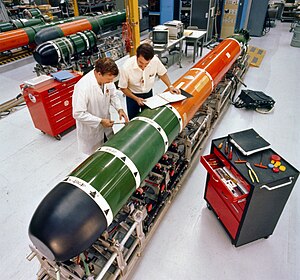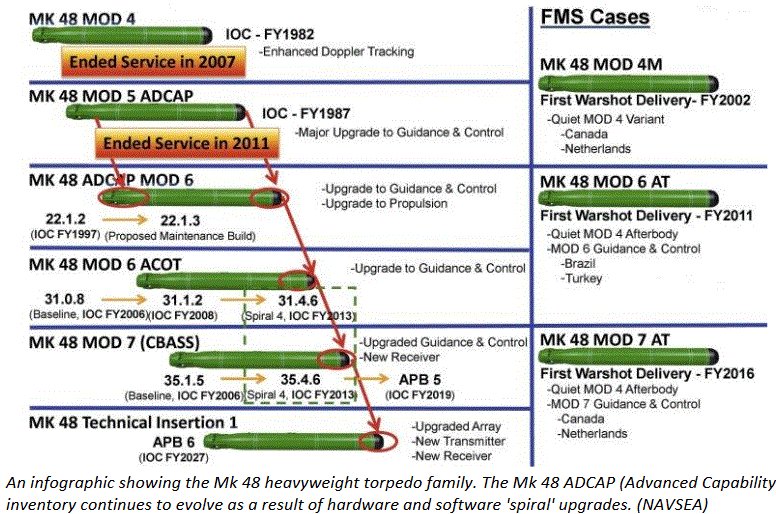Mark 48 torpedo

|
|
| Technical specifications | |
|---|---|
| Commissioning |
1972 ADCAP 1989 |
| Length: | 5.79 meters |
| Diameter: | 533 millimeters |
| Weight: | 1545.3 kg ADCAP: 1662.75 kg |
| Speed: | official: more than 28 kn (52 km / h) assumed: 55 kn (102 km / h) |
| Range: | official: more than 5 nm (8 km) assumed: 32 km at 55 kn |
| Diving depth: | official: more than 1200 feet (365 meters) assumed: 1000 meters |
| Warhead: | 295 kg PBX explosives (544 kg TNT equivalent ) |
The Mark 48 or Mk 48 for short is a heavyweight torpedo used in the United States Navy as well as the Canadian , Australian and Dutch navies . It can only be shot down by submarines .
Versions
In total, the US Navy owns 1046 Mk. 48 ADCAPs, the Australian Navy has 20 according to reports.
Over time, the Mark 48 has been improved several times, resulting in the following versions:
Mark 48
The development of the Mark 48 began in 1957 with feasibility studies , in 1960 the specifications were formulated. At this point the torpedo should still be supported both under and above the water, the latter requirement being soon canceled. The torpedo, with a diameter of 533 mm and a length of 5.79 m, was finally ready for use in 1972. Test shots were carried out in the polar region, among other places, which places high demands on the sonar system due to the rubbing of the pack ice .
The torpedo uses a nozzle ring propeller that is moved by a piston engine . With this system, the Mark 48 can reach speeds of up to 55 knots with ranges of an estimated 35,000 yards (32 km). Here, Otto 2 used, which contains the necessary for its combustion oxidizer already.
The cost of the standard execution amounted to good 2.3 million US dollars per unit. It weighs 1545.3 kg.
Mark 48 Mod.5 (ADCAP)
The ADCAP version of the Mark 48 (ADCAP = Ad vanced Cap ability, German improved skills ) was delivered to the US Navy from the 1989th Above all, the effectiveness against surface units has been improved, the torpedo can now better recognize countermeasures and avoid them, and the distance that is possible to catch a target has been increased. On board the submarine, the time it takes to warm up the torpedo has been reduced.
It was first shot down by an ADCAP on July 23, 1988 when the USS Norfolk (SSN-714) sank the decommissioned destroyer USS Jonas Ingram (DD-938) .
The ADCAP is manufactured by Raytheon .
Mark 48 Mod.6 (MODS ADCAP)
Torpedoes after MODS ADCAP standard (from 1995) included two hardware upgrades that G & C-MOD (Guidance and Control, German destination search and control ) and the TPU MOD (Torpedo Propulsion Upgrade, German torpedo drive upgrade ). At the G & C-MOD, the homing systems were brought up to date. The sonar systems were replaced, and the torpedo received more memory and more processor power . The TPU-MOD improves the drive system in a way that is not explained in detail. The maximum range of an ADCAP should be over 40,000 yards (approx. 37 km).
The cost of an ADCAP unit is expected to be around $ 3.5 million; the weight of a torpedo increased to 1662.75 kg.
The MODS ADCAP is manufactured by Northrop Grumman .
Mark 48 Mod.7 (CBASS)
The development of the CBASS version ( Common Broadband Advanced Sonar System , German common advanced broadband sonar system ) began in 1998, from 2002 it was put into service. With new control and guidance technology, it improves performance in shallow coastal waters, against new generations of very quiet diesel-electric submarines and improved countermeasures. A CBASS torpedo was used for the first time in 2008 during exercise RIMPAC , when the Australian submarine HMAS Waller (SSG 75 ) sank the US destroyer USS Fletcher (DD-992) .
commitment
The torpedo entered service in 1972. It is carried by Ohio , Los Angeles , Seawolf and Virginia class submarines . The Mark 48 can be used against both underwater and surface targets, detonating under the keel of the target and lifting the ship into the air by the resulting pressure wave. The keel breaks here, as the actual explosion hits the target a short time later.
The torpedoes are wire-controlled, which means that they pull a thin cable behind them, which the operator on board the submarine can use to influence the lock on to a target. As a sonar system , the torpedo has both active and passive sonar on board, which is switched to active when the target is approached . The Mark 48 are able to run programmed search patterns, they can also turn around after missing the target in order to attack the target again. The ADCAP version is able to report back data from its target sensors to the BSY-1 electronic combat system of the US boats of type 688 (I)
Web links
- Thoralf Doehring / Michael Jenning: MK-48 Torpedo on navysite.de (engl.)
- Federation of American Scientists : MK-48 Torpedo on fas.org (Eng.)
- GlobalSecurity.org : MK-48 torpedo at globalsecurity.org (Engl.)
- Australian Torpedo Test (does not specify whether this is actually a MK-48)
